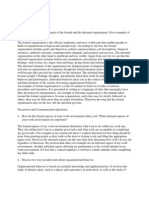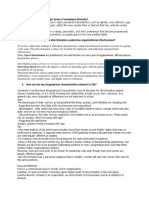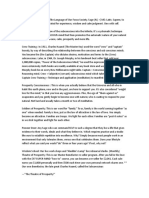Organizational Behavior, 8e: Schermerhorn, Hunt, and Osborn
Organizational Behavior, 8e: Schermerhorn, Hunt, and Osborn
Uploaded by
Sagar ParajiyaCopyright:
Available Formats
Organizational Behavior, 8e: Schermerhorn, Hunt, and Osborn
Organizational Behavior, 8e: Schermerhorn, Hunt, and Osborn
Uploaded by
Sagar ParajiyaOriginal Title
Copyright
Available Formats
Share this document
Did you find this document useful?
Is this content inappropriate?
Copyright:
Available Formats
Organizational Behavior, 8e: Schermerhorn, Hunt, and Osborn
Organizational Behavior, 8e: Schermerhorn, Hunt, and Osborn
Uploaded by
Sagar ParajiyaCopyright:
Available Formats
Organizational
Behavior, 8e
Schermerhorn, Hunt, and
Osborn
Prepared by
Michael K. McCuddy
Valparaiso University
John Wiley & Sons, Inc.
Organizational Behavior: Chapter 4 2
COPYRIGHT
Copyright 2003 John Wiley & Sons, Inc. All rights reserved.
Reproduction or translation of this work beyond that permitted in Section
117 of the 1976 United States Copyright Act without the express written
permission of the copyright owner is unlawful. Request for further
information should be addressed to the Permissions Department, John Wiley
& Sons, Inc. The purchaser may make back-up copies for his/her own use
only and not for distribution or resale. The Publisher assumes no
responsibility for errors, omissions, or damages, caused by the use of these
programs or from the use of the information contained herein.
Organizational Behavior: Chapter 4 3
Chapter 4
Diversity and Individual Differences
Study questions.
What is workplace diversity, and why is it
important?
What are demographic differences among
individuals, and why are they important?
What are aptitude and ability differences
among individuals, and why are they
important?
Organizational Behavior: Chapter 4 4
Chapter 4
Diversity and Individual Differences
Study questions cont.
What are personality determinants and
differences among individuals, and why are
they important?
What are value and attitude differences among
individuals, and why are they important?
What does managing diversity and individual
differences involve, and why is it important?
Organizational Behavior: Chapter 4 5
What are demographic differences among
individuals, and why are they important?
Demographic characteristics.
The background characteristics that help shape what a
person becomes.
Important demographic characteristics for the
workplace.
Gender.
Age.
Race.
Ethnicity.
Able-bodiedness.
Organizational Behavior: Chapter 4 6
What are demographic differences among
individuals, and why are they important?
Gender.
No consistent differences between men and
women in:
Problem-solving abilities.
Analytical skills.
Competitive drive.
Motivation.
Learning ability.
Sociability.
Organizational Behavior: Chapter 4 7
What are demographic differences among
individuals, and why are they important?
Gender cont.
As compared to men, women:
Are more conforming.
Have lower expectations of success.
Have higher absenteeism.
Have lower earnings.
Organizational Behavior: Chapter 4 8
What are demographic differences among
individuals, and why are they important?
Age.
Older workers
Are often stereotyped as inflexible.
Sometimes complain that their experience and
skills are not valued.
Have lower turnover.
Have lower avoidable absences.
Organizational Behavior: Chapter 4 9
What are demographic differences among
individuals, and why are they important?
Able-bodiedness.
Despite evidence of effective job performance,
most disabled persons are unemployed.
Most disabled persons want to work.
More firms are likely to hire disabled workers
in the future.
Organizational Behavior: Chapter 4 10
What are demographic differences among
individuals, and why are they important?
Racial and ethnic groups.
African Americans, Asian Americans, and
Hispanic Americans make up an ever-
increasing percentage of the American
workforce.
Potential for stereotypes and discrimination
can adversely affect career opportunities.
Organizational Behavior: Chapter 4 11
What are demographic differences among
individuals, and why are they important?
Important lessons regarding demographic
characteristics.
Respect and deal with the needs and concerns
of people with different demographics.
Avoid linking demographics to stereotypes.
Demography is not a good indicator of
individual-job fits.
Organizational Behavior: Chapter 4 12
What are aptitude and ability differences
among individuals, and why
are they important?
Aptitude.
A persons capability of learning something.
Ability.
A persons existing capacity to perform the
various tasks needed for a given job.
Includes relevant knowledge and skills.
Organizational Behavior: Chapter 4 13
What are aptitude and ability differences
among individuals, and why
are they important?
Aptitude and ability tests may be used as
employment screens in the hiring process.
To be legal, employment tests must
accurately predict job success.
Organizational Behavior: Chapter 4 14
What are personality determinants and
differences among individuals,
and why are they important?
Personality.
The overall profile or combination of
characteristics that capture the unique nature
of a person as that person reacts and interacts
with others.
Combines a set of physical and mental
characteristics that reflect how a person looks,
thinks, acts, and feels.
Organizational Behavior: Chapter 4 15
What are personality determinants and
differences among individuals,
and why are they important?
Personality determinants and development.
Is personality genetically determined, or is it
formed by experience?
Heredity sets the limits on the development of
personality characteristics.
Environment determines development within
these limits.
Across all characteristics there is about a 50-
50 heredity-environment split.
Organizational Behavior: Chapter 4 16
What are value and attitude
differences among individuals,
and why are they important?
Attitudes and cognitive consistency
cont.
Dissonance reduction choices are influenced
by:
The degree of control a person has over the
situation.
The magnitude of the rewards involved.
Organizational Behavior: Chapter 4 17
What does managing diversity and
individual differences involve,
and why is it important?
Dealing with diversity and individual
differences is one of the most important
issues challenging managers.
Applies in the:
United States.
Canada.
European Union countries.
Several Asian countries.
Organizational Behavior: Chapter 4 18
What does managing diversity and
individual differences involve,
and why is it important?
Examples of managing workplace
diversity.
Harvard Pilgrim Health Care.
Coors Brewing Company.
Microsoft.
You might also like
- Getting Ahead: Three Steps to Take Your Career to the Next LevelFrom EverandGetting Ahead: Three Steps to Take Your Career to the Next LevelRating: 4.5 out of 5 stars4.5/5 (4)
- Organizational Behavior Directed StudyDocument37 pagesOrganizational Behavior Directed StudyBrenda Williams PughNo ratings yet
- Organizational Culture Exercise: Leadership For Health Professionals Ledlow, Gerald and Nicholas CoppolaDocument7 pagesOrganizational Culture Exercise: Leadership For Health Professionals Ledlow, Gerald and Nicholas CoppolaVipin NairNo ratings yet
- Chapter 4Document8 pagesChapter 4komal4242No ratings yet
- Module 4Document27 pagesModule 4Amanda Smith100% (1)
- Chapter 2Document16 pagesChapter 2golfwomann100% (1)
- Organizational Behavior ICMR WorkbookDocument268 pagesOrganizational Behavior ICMR WorkbookSarthak Gupta67% (12)
- Managing Workplace Diversity: Building Effective and Efficient Work RelationshipsFrom EverandManaging Workplace Diversity: Building Effective and Efficient Work RelationshipsNo ratings yet
- Sharda dss10 PPT 01Document41 pagesSharda dss10 PPT 01Aniket KaushikNo ratings yet
- Bme 2102-m2Document4 pagesBme 2102-m2MG GadonNo ratings yet
- Ob QuizesDocument2 pagesOb QuizesstfypradoNo ratings yet
- Coaching Public Service Leaders: Seven Practices Good Leaders MasterFrom EverandCoaching Public Service Leaders: Seven Practices Good Leaders MasterNo ratings yet
- Successful Project Management 7th Edition by Guido 1Document17 pagesSuccessful Project Management 7th Edition by Guido 1dean100% (59)
- Chapter 2 - DevirsityDocument3 pagesChapter 2 - DevirsitySamir AlshafalyNo ratings yet
- Chapter 14-Organizational BehaviourDocument54 pagesChapter 14-Organizational BehaviourBinh NguyenNo ratings yet
- Introduction To Organizational BehaviorDocument2 pagesIntroduction To Organizational BehaviorFrank GarvidaNo ratings yet
- CH09 OrganizationalCultureExerciseDocument8 pagesCH09 OrganizationalCultureExerciseMoushumi DharNo ratings yet
- OBS 114 Chapters 3B-6Document7 pagesOBS 114 Chapters 3B-6cmsdralisNo ratings yet
- Leadership Agility: Five Levels of Mastery for Anticipating and Initiating ChangeFrom EverandLeadership Agility: Five Levels of Mastery for Anticipating and Initiating ChangeRating: 4 out of 5 stars4/5 (6)
- Lecture 4 Organizational BehaviorDocument12 pagesLecture 4 Organizational Behaviorcpie52758No ratings yet
- Notes - CH 1 Intro To OB - 9 Jan 2023Document48 pagesNotes - CH 1 Intro To OB - 9 Jan 2023Kaizen KohNo ratings yet
- CH 04Document41 pagesCH 04Alastair_Reid_3300No ratings yet
- The Role of Human Resources in Managing DiversityDocument37 pagesThe Role of Human Resources in Managing DiversityGaurav MoorjaniNo ratings yet
- Leadership Plus Report ENFP Sample1Document15 pagesLeadership Plus Report ENFP Sample1Allan Leon CasemiroNo ratings yet
- Organizational Behavior: Chapter 4: Personality and ValuesDocument32 pagesOrganizational Behavior: Chapter 4: Personality and ValueshiigeeNo ratings yet
- Workforce DiversityDocument31 pagesWorkforce Diversityhr14No ratings yet
- Diversity in OrganizationsDocument21 pagesDiversity in OrganizationsJahidul IslamNo ratings yet
- All Mba ObDocument202 pagesAll Mba Ob9986212378No ratings yet
- BUS201 202 Tutorial 02 SolutionsDocument3 pagesBUS201 202 Tutorial 02 SolutionsBellNo ratings yet
- Organisational BehaviourDocument43 pagesOrganisational Behaviourpranayrathore750No ratings yet
- IndividualDocument90 pagesIndividualJulia DanielNo ratings yet
- A Model With Methods and Procedures For Analyzing Diversity BUS 610 Assn 2 WK 2Document7 pagesA Model With Methods and Procedures For Analyzing Diversity BUS 610 Assn 2 WK 2Roberta OrrNo ratings yet
- Individual Behavior in Org.Document47 pagesIndividual Behavior in Org.Jeni-rose AndradeNo ratings yet
- Session 13 LD11 Authentic LeadershipDocument22 pagesSession 13 LD11 Authentic LeadershiprajatvarnaNo ratings yet
- Organizational BehaviourDocument220 pagesOrganizational BehaviourDavid Wright100% (1)
- 4.ME403 OB Week 4 Outline The Individual Behavior 2021 Rev0Document6 pages4.ME403 OB Week 4 Outline The Individual Behavior 2021 Rev0GeckoNo ratings yet
- Ba5105 Organizational Behaviour 2 Marks Questions Unit - I 1. What Is OB?Document19 pagesBa5105 Organizational Behaviour 2 Marks Questions Unit - I 1. What Is OB?Rajesh Arumugam100% (1)
- Organizational Culture 2Document27 pagesOrganizational Culture 2Shamil MurmooNo ratings yet
- Hrm-Essay QuestionsDocument6 pagesHrm-Essay QuestionsBisag AsaNo ratings yet
- Adapt Your Leadership StyleDocument6 pagesAdapt Your Leadership StyleĐào Hải Hảo100% (1)
- Social Perception and Managing DiversityDocument28 pagesSocial Perception and Managing DiversityYusuf ArifinNo ratings yet
- Diversity in OrganizationsDocument28 pagesDiversity in OrganizationsHaneenNo ratings yet
- Introduction To Organizational Behavior: Prof. Saranbir UppalDocument50 pagesIntroduction To Organizational Behavior: Prof. Saranbir UppalRahul kamdiNo ratings yet
- CH 05 Personality ValuesDocument31 pagesCH 05 Personality ValuesAkhilAgrawalNo ratings yet
- 09 VE PDQR WT SHS Delarjg U4L3Document12 pages09 VE PDQR WT SHS Delarjg U4L3SlyreeNo ratings yet
- BOB2024 Tutorial Questions and New CasesDocument5 pagesBOB2024 Tutorial Questions and New CasesTayalan ArmugamNo ratings yet
- HBO IntroDocument178 pagesHBO IntroZandro Umangay IcoNo ratings yet
- Reflection#2 VICENTE VETHINA BSC2-4Document4 pagesReflection#2 VICENTE VETHINA BSC2-4VethinaVirayNo ratings yet
- Leadership Lessons from West PointFrom EverandLeadership Lessons from West PointMajor Doug CrandallNo ratings yet
- Managing Diversity: Releasing Every Employee'S PotentialDocument12 pagesManaging Diversity: Releasing Every Employee'S PotentialMUHAMMAD ASYRAF ILHAM HRNo ratings yet
- COURSE Outline ORGANIZATIONAL BEHAVIOR MAEDDocument15 pagesCOURSE Outline ORGANIZATIONAL BEHAVIOR MAEDKristine Mae B QuiapoNo ratings yet
- Term Paper of Mp&obDocument30 pagesTerm Paper of Mp&obbhatt1987No ratings yet
- Strategic Leadership for Sustainable Personal and Organizational SuccessFrom EverandStrategic Leadership for Sustainable Personal and Organizational SuccessNo ratings yet
- Diversity Prince Dudhatra 9724949948Document52 pagesDiversity Prince Dudhatra 9724949948pRiNcE DuDhAtRaNo ratings yet
- Chapter 15 HRD and Diversity: Marissa BamfordDocument18 pagesChapter 15 HRD and Diversity: Marissa BamfordMabelle Marie CutaraNo ratings yet
- Diversity in OrganisationDocument22 pagesDiversity in OrganisationAbubakar HabibullahNo ratings yet
- Employee Resource Group Excellence: Grow High Performing ERGs to Enhance Diversity, Equality, Belonging, and Business ImpactFrom EverandEmployee Resource Group Excellence: Grow High Performing ERGs to Enhance Diversity, Equality, Belonging, and Business ImpactNo ratings yet
- Organizational Behavior Essentials You Always Wanted To Know: Self Learning ManagementFrom EverandOrganizational Behavior Essentials You Always Wanted To Know: Self Learning ManagementRating: 5 out of 5 stars5/5 (1)
- The 400-Year Holocaust Toolkit and Workbook: Changing and Shaping Culture One Leader and Practice At A Time - Tools and Strategies for Addressing Anti-Blackness, White Supremacy, and Racism in your OrganizationFrom EverandThe 400-Year Holocaust Toolkit and Workbook: Changing and Shaping Culture One Leader and Practice At A Time - Tools and Strategies for Addressing Anti-Blackness, White Supremacy, and Racism in your OrganizationNo ratings yet
- 1 Characteristics, Strengths, Weaknesses, and Kinds of Quantitative ResearchDocument30 pages1 Characteristics, Strengths, Weaknesses, and Kinds of Quantitative ResearchHarry StylesNo ratings yet
- Journal Using Articles in EssaysDocument7 pagesJournal Using Articles in EssaysHenryNo ratings yet
- PanamokDocument3 pagesPanamokRedMoonLightNo ratings yet
- 1eso Unidad 1Document11 pages1eso Unidad 1Nerea MongeNo ratings yet
- A Stylistic Approach To The God of Small Things PDFDocument75 pagesA Stylistic Approach To The God of Small Things PDFJenif Roque100% (1)
- Motivational InterviewingDocument7 pagesMotivational InterviewingMariajudithNo ratings yet
- (Timothy E. Eastman, Hank Keeton) Physics and Whit (BookFi) PDFDocument343 pages(Timothy E. Eastman, Hank Keeton) Physics and Whit (BookFi) PDFvaleria limboNo ratings yet
- Slobin-1996-Two Ways To TravelDocument13 pagesSlobin-1996-Two Ways To TravelMili OrdenNo ratings yet
- How To ReprogramDocument5 pagesHow To ReprogramGeorgeNo ratings yet
- Session 4 - Groups and Teams in Action - 23 - ReportsDocument16 pagesSession 4 - Groups and Teams in Action - 23 - ReportsNam NguyễnNo ratings yet
- Objectives For Speaking SMARTDocument2 pagesObjectives For Speaking SMARTCamy ErazoNo ratings yet
- Sarah LombardiDocument3 pagesSarah LombardiSarah LombardiNo ratings yet
- Creative Design Process PDFDocument21 pagesCreative Design Process PDFdanielNo ratings yet
- QuestionnairesDocument2 pagesQuestionnairesDexie FerolinoNo ratings yet
- Jonalyn DomingoDocument6 pagesJonalyn DomingoAira Marie ValenciaNo ratings yet
- 3248 Second Language Urdu: MARK SCHEME For The May/June 2009 Question Paper For The Guidance of TeachersDocument5 pages3248 Second Language Urdu: MARK SCHEME For The May/June 2009 Question Paper For The Guidance of Teachersmstudy123456No ratings yet
- COD601 Writing A Case Study EssayDocument32 pagesCOD601 Writing A Case Study EssayShivali RS SrivastavaNo ratings yet
- I-Day 4Document6 pagesI-Day 4CRISTILE ANN GESMANNo ratings yet
- Teacher DispositionDocument3 pagesTeacher Dispositionapi-283801432No ratings yet
- The Hand of God: Vocabulary Study WorksheetDocument2 pagesThe Hand of God: Vocabulary Study WorksheetAdriana BrebenelNo ratings yet
- The Logic of Causation: Definition, Induction and Deduction of Deterministic Causality.Document384 pagesThe Logic of Causation: Definition, Induction and Deduction of Deterministic Causality.Avi Sion100% (2)
- English - The Universal Language On The Internet - KEYDocument3 pagesEnglish - The Universal Language On The Internet - KEYFabian SarmientoNo ratings yet
- Do You QuantumThink? Dianne Collins Enlightenment 123 by Liz SterlingDocument3 pagesDo You QuantumThink? Dianne Collins Enlightenment 123 by Liz SterlingLiz Shoher SterlingNo ratings yet
- Career Aspiration PublicationDocument9 pagesCareer Aspiration PublicationulorNo ratings yet
- Can I Have Your Attention - How To Think Fast, Find Your Focus, and Sharpen Your Concentration (PDFDrive)Document130 pagesCan I Have Your Attention - How To Think Fast, Find Your Focus, and Sharpen Your Concentration (PDFDrive)Manel PaivaNo ratings yet
- Ethics and Values EducationDocument26 pagesEthics and Values Educationdominic nicart0% (1)
- 03 Heinzen The Social SelfDocument34 pages03 Heinzen The Social SelfAnjolina BautistaNo ratings yet
- Topic: Be Helpful: Lesson PlanDocument5 pagesTopic: Be Helpful: Lesson PlanDulap LiviaNo ratings yet
- Methods and Approaches in Language TeachDocument6 pagesMethods and Approaches in Language TeachNawazish AliNo ratings yet

























































































